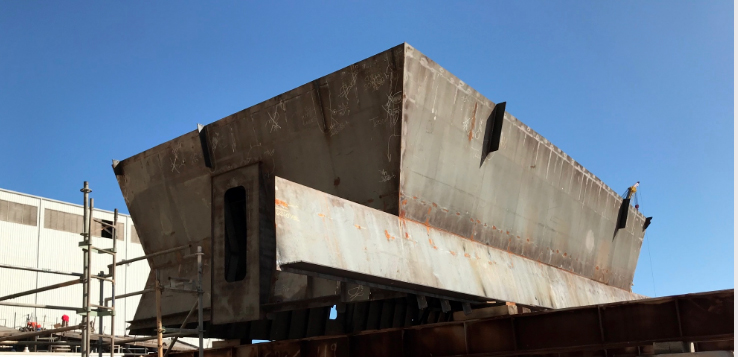Detroit’s LIFT, “Lightweight Innovations For Tomorrow,” a Manufacturing USA institute, announced the creation of a new process which introduces the opportunity for shipbuilders to save production costs and improve build time — all while reducing distortion of lightweight materials.
The Joining-3 Project, led by Huntington Ingalls Industries’ Ingalls Shipbuilding division, with partners in government, NSWC-Carderock Division, NAVSEA and industry, including American Bureau of Shipping (ABS), Comau, ESI, and research, including the University of Michigan, EWI, Massachusetts Institute of Technology and The Ohio State University, developed innovative computer modeling to better predict where distortion, or warping, will occur when steel plates are welded together, ultimately reconfiguring the welding sequence. Using a U.S. Coast Guard Cutter unit as a test article, the project team demonstrated a 30% reduction in distortion and a 13% reduction in production costs compared to similar, previous cutter production units.
“As naval ship designs have trended toward using thinner and higher strength materials to reduce structural weight and add new combat capability, controlling the quality and cost of distortion has increasingly and adversely affected the shipbuilding industry,” said T.D. Huang, Principal Engineer, Huntington Ingalls Industries. “The LIFT project has provided an avenue to collaborate with world-class experts and systematically address thin steel distortion.”
The Joining-3 Project team took a five-pronged approach, conducted over a 2-year period, which included:
- Observing the baseline Coast Guard Cutter production assembly and collecting distortion data at each process step;
Fabricating nineteen (19) test panels featuring different variables and assembly sequences; - Employing Integrated Computational Materials Engineering (ICME) modeling to establish recommended fitting, welding and assembly sequences for optimized distortion control;
- Recommended procedures were employed on a full-scale mock-up unit; and
- Detailing process flows to determine the change in cost due to improved technology and reduced distortion.
“Developing better modeling to enable lightweight solutions is a big step forward for manufacturers across the country, and across industries,” said Alan Taub, Chief Technology Officer, LIFT. “Lightweighting is more than just substituting materials. It can be achieved through optimal engineering too.”
The modeling and streamlined process is currently being implemented by Ingalls through ICME analysis and utilization of the cost model to predict changes in design and the associated cost impact across all production platforms.
A follow-on project to evaluate advanced steel alloys for ICME implementation has been approved by LIFT for kick-off this summer.
LIFT, operated by the American Lightweight Materials Manufacturing Innovation Institute (ALMMII), is a Detroit-based, public-private partnership committed to the development and deployment of advanced lightweight metal manufacturing technologies, and implementing education and training initiatives to better prepare the workforce today and in the future. LIFT is one of the founding institutes of Manufacturing USA, and is funded in part by the Department of Defense with management through the Office of Naval Research. Visit www.lift.technology or Twitter @NewsFromLIFT to learn more.
